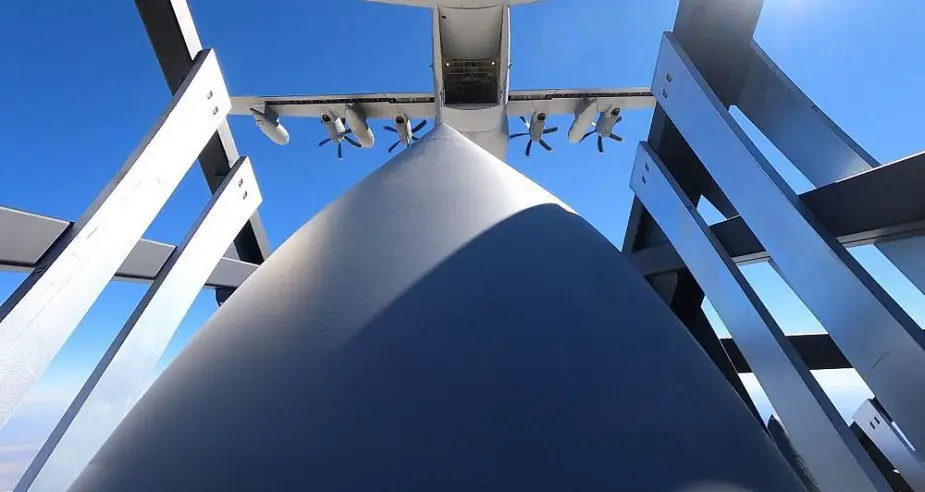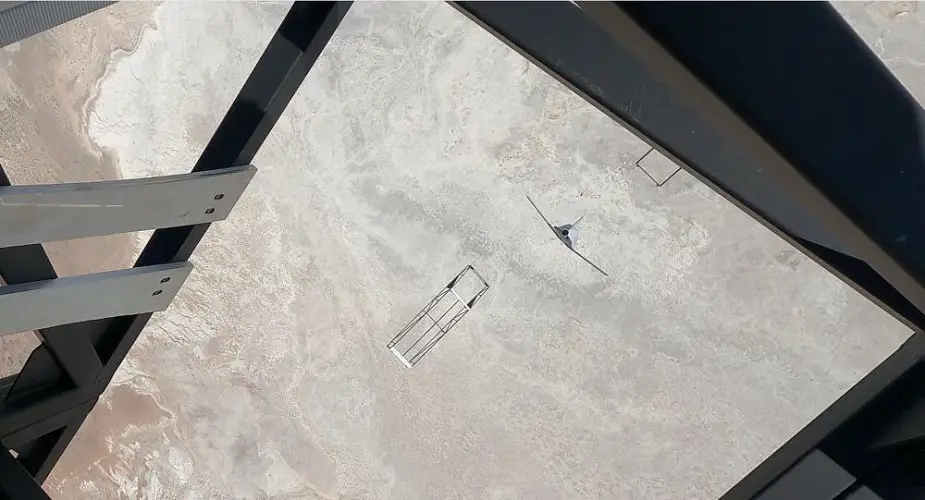Breaking news
US Air Force Rapid Dragon Program conducts palletized munition demonstration using production long range cruise missile separation test vehicle.
The Air Force Rapid Dragon Program, a fast-paced experimentation campaign led by the Air Force Strategic Development Planning and Experimentation (SDPE) office, completed another successful flight demonstration November 3.
Follow Air Recognition on Google News at this link
 US Air Force personnel load a Rapid Dragon deployment system onto an MC-130J aircraft ahead of an airdrop. Rapid Dragon is compatible with standard airlift inventory systems and provides a roll-on, roll-off capability with no aircraft modifications (Picture source: AFRL)
US Air Force personnel load a Rapid Dragon deployment system onto an MC-130J aircraft ahead of an airdrop. Rapid Dragon is compatible with standard airlift inventory systems and provides a roll-on, roll-off capability with no aircraft modifications (Picture source: AFRL)
The test, conducted at White Sands Missile Range, demonstrated the deployment of a production long range cruise missile separation test vehicle, or STV – a cruise missile without an engine and warhead – from the palletized weapons system.
While the aircraft was enroute to the White Sands Missile Range drop zone, the crew used a beyond-line-of-sight (BLOS) command and control node to receive new targeting data for the onboard Battle Management System (BMS). The BMS then uploaded the targeting data to the palletized weapon. The aircraft agnostic BMS’s inflight receipt and upload of the new targeting data into the STV was a first-time achievement; all previous BLOS retargeting demonstrations used a cruise missile emulator.
At White Sands Missile Range, the MC-130J airdropped a four-cell Rapid Dragon deployment system containing the STV and three mass simulants, which sequentially released from the palletized system. Seconds after release, the STV deployed its wings and tail, achieved aerodynamic control, and began a pull-up maneuver as it glided toward its new target.
 An airdropped Palletized Munition Deployment System carrying a production long range cruise missile STV and three mass simulants. The photo shows a cruise missile in the Deployment Box immediately after being airdropped from an MC-130J (Picture source: AFRL)
An airdropped Palletized Munition Deployment System carrying a production long range cruise missile STV and three mass simulants. The photo shows a cruise missile in the Deployment Box immediately after being airdropped from an MC-130J (Picture source: AFRL)
In addition to showcasing the utility of delivering stand-off munitions en masse via mobility aircraft, this palletized munition demonstration repeated and validated several milestone events from previous Rapid Dragon tests using a production long range cruise missile, including:
• Successful high-altitude airdrop using a modular Rapid Dragon deployment system
• Successful jettison of multiple weapons from the Rapid Dragon deployment system
• Weapon de-confliction through the clean separation of the STV and multiple cruise missile simulants
“In future conflict scenarios against strategic competitors, the ability to cost-effectively deliver long-range standoff weapons en masse from non-traditional platforms expands warfighting flexibility and introduces new deterrence options,” said Dr. Dean Evans, Rapid Dragon program manager.
An operational AFSOC aircrew conducted the airdrop, once again demonstrating the feasibility of a palletized delivery of long-range strike weapons in an operationally relevant environment. Demonstration participants included the Naval Surface Warfare Center-Dahlgren; Standoff Munitions Application Center; Lockheed Martin Missiles and Fire Control; Systima Technologies; and Safran Electronics & Defense, Parachutes USA.
 Once the Palletized Munition Deployment System was stabilized under the parachutes, the production long range cruise missile STV and mass simulants were released sequentially, timed for safe separation between munitions. The photo shows a successful separation of a STV from the sabot following the weapon release, followed by the deployment of the STV’s control surfaces (wings and tail) (Picture source: AFRL)
Once the Palletized Munition Deployment System was stabilized under the parachutes, the production long range cruise missile STV and mass simulants were released sequentially, timed for safe separation between munitions. The photo shows a successful separation of a STV from the sabot following the weapon release, followed by the deployment of the STV’s control surfaces (wings and tail) (Picture source: AFRL)
This demonstration paves the way for the first deployment of a live long range cruise missile under powered flight from an AFSOC MC-130J. This test will inform potential design refinement and accelerate the maturation of these systems for further experimentation and rapid fielding. A follow-on program will look at expanding the Rapid Dragon portfolio to include additional weapon systems and multiple effects capabilities.
Rapid Dragon could ultimately lead to a roll-on, roll-off system that transforms mobility aircraft into lethal strike platforms that augment the strike capacity of tactical fighters and strategic bombers. The retargeting methodology used is transferrable to other strike and cargo platforms, potentially increasing lethality of all long range cruise missiles strike assets.
SDPE’s Rapid Dragon Program is progressing from concept to powered flight/live fire within 24 months. From a modular pallet design to a flight test in only 10 months, this nontraditional acquisition program continues to take risks and push the developmental envelope, accelerating change to deliver operationally relevant capabilities for the Future Force.


























